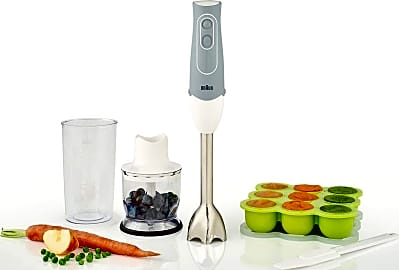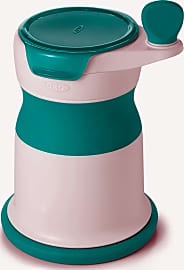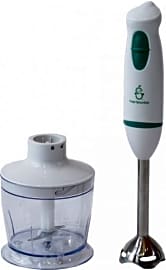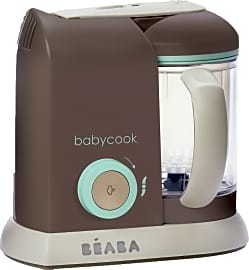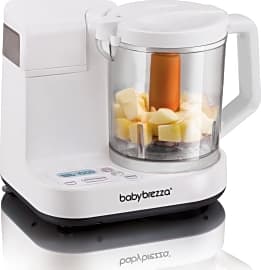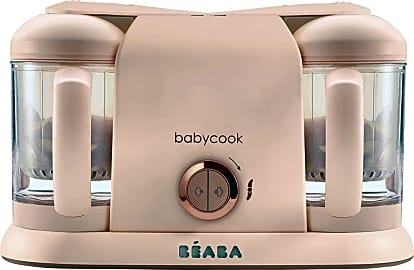The 10 Best Baby Food Makers

This wiki has been updated 38 times since it was first published in May of 2015. Ensure your youngster gets the right nutrition without any potentially harmful added chemicals or preservatives by preparing his or her meals yourself using one of these baby food makers. Many can either puree or steam fruits and vegetables, and they come in compact sizes that are easy to store and transport, as well as larger, powerful models that can process big batches at a time. When users buy our independently chosen editorial recommendations, we may earn commissions to help fund the Wiki.
Editor's Notes
May 09, 2020:
In today’s update, we added in a couple of compact, user-friendly models that are great for anyone who doesn’t want to add another sizable appliance to their countertop and kitchen cabinets. Neither of these models is capable of heating the food, unlike several others on our list that double as steamers, but they’re exactly what some parents are looking for as a quick, convenient way of making a healthy meal or two for their baby. The Braun MultiQuick 5 is an immersion blender that can finely chop or evenly blend fruits or vegetables into smooth purees. The bell-shaped wand tip helps keep splashes at bay, for an easy cleanup. This model is also good for making adult foods like soups, sauces, and smoothies, providing more bang for your buck. It offers two speed settings and a curved design that’s comfortable in the hand. It’s somewhat similar in design to the Sage Spoonfuls Immersion, but comes with more accessories like the large blending beaker, nine-slotted freezer tray, and a rubber spatula. The Oxo Tot Mash Mill is another compact choice, which is around the size of a coffee mug and is easy to pack up and take on trips or visits to grandma’s. Its nonskid base provides stability while you’re milling. Just add in more liquid, as desired, to control the thickness. You can easily serve the pureed food with a spoon straight from the container, so you won’t have to bother with a separate bowl.
For a model that can serve as a steamer and a chopper, look to the Cuisinart BFM-1000. It features a dial with a bright indicator light, and you can just turn it to your desired setting. Its four-cup bowl has a splatter-proof lid for mess-free processing. It conveniently can be used as a bottle warmer as well. Retaining its number one spot is the Magic Bullet Baby, which consists of a 20-piece set that enables you to make a week’s worth of fresh, homemade meals with ease. In addition to the high-torque, 200-watt base and the attachment bowl, you’ll get six lidded storage containers, a six-batch freezer tray, and a handled cup with a lid. It’s also equipped with both a blending blade and a milling one, as well as a soft spatula and a pocket nutrition guide. It’s backed by a one-year warranty, so you can buy it with confidence. It’s one of several popular Magic Bullet blender sets available from the manufacturer.
These devices contain sharp blades, and some can get quite hot during operation, so be sure to keep them out of the reach of children. For cleaning purposes, be sure to read the manufacturer’s instructions, as some are safe for the dishwasher while others need to be washed by hand.
Special Honors
NutriBullet Baby You can quickly puree and store a wide variety of fresh foods for your little one with this compact appliance. In addition to the motorized base, it comes with an extractor blade, a large bowl attachment, one medium and six small storage cups, and a lidded freezer tray that incorporates six portion sizes. All non-motorized components are dishwasher safe, and included is a recipe book to help you get started. nutribullet.com
Choosing The Best Baby Foods
When a newborn first enters the world, initially he or she will be fed nothing but breast milk, formula, or a combination of the two.
Every parent wants nothing but the best for their child. That means a rewarding career, the finest university education, the best secondary schools, a wonderful summer camp, great music teachers, and on and on ad nauseam. But it all starts with a parent ensuring that their child is healthy and well-nourished. When a newborn first enters the world, initially he or she will be fed nothing but breast milk, formula, or a combination of the two. This will hold true for several months, but by the time an infant has reach four months of age, most children will be ready for the introduction of foods.
Introducing foods early has two major benefits: first, it allows a parent to ensure their child begins to ingest a balanced diet that will help fortify the youngster with all the nutrients they need for ideal development. Second, early food introduction helps to expose those young taste buds to an array of flavors, broadening their palate from those earliest months. The more tastes and textures a child eats when young, the more foods they will appreciate later, and the less the parents will have to deal with a fussy eater.
The first foods an infant eats are so thoroughly pureed as to be almost liquefied. Traditionally, parents first introduced their young ones to foods like apple sauce and rice-based cereals that offered minimal nutritional value and certainly did little to awaken an appreciation for a variety of tastes. Today many brands have begun to offer a wide array of infant foods intended for kids as young as four to six months of age that consist of a blend of several foods and that are rich in flavor and nutrition. It's not uncommon to find a child still under half a year of age enjoying a blend containing everything from pears to spinach to butternut squash. And while not every exotic blend of food is going to tickle the taste buds of every infant or toddler, the patient parent will be able to find a plethora of pureed foods their child will enjoy and that will help develop them into a world class eater.
For the even more involved, adventurous parent, though, the best baby foods around may well be the ones made right there at home. Whether you're struggling to find a blend of flavors your child will actually love, if you're looking to save money by preparing foods at home, or whether you simply want to make sure you know exactly what your child is eating at all times, homemade baby food is a perfectly viable option. And that's especially true if you have a great baby food maker at your disposal.
Choosing The Best Baby Food Maker
All baby food makers can blend foodstuffs into smooth purees, ensuring small mouths without many (or any) teeth can handle the foods they create. What separates baby food makers into categories is whether or not they can also cook the foods you want to serve.
A pureeing baby food maker is also often an affordable choice.
If you're only interested in preparing smoothies and blends using fresh (or frozen) raw ingredients like fruits and vegetables, then a baby food maker that merely blends and purees foods is absolutely sufficient. These options are essentially just highly efficient food processors, but many are designed as modular systems that work well with food storage and/or serving containers, and they make it easier to prepare foods for travel, refrigeration, or freezing. A pureeing baby food maker is also often an affordable choice.
On the other hand, many baby food makers can cook and then blend foods, and these units can save a parent time and effort, which any busy parent will tell you is a luxury well worth the added expense. And while said expense can often be high, serving your child homemade baby food is ultimately much more affordable than a diet consisting of any high-quality store bought organic baby food will be; simply put, making your own baby food will save you money, even if your baby food maker seems like a large initial investment.
Baby food makers that cook their own foods do so using steam heat, which can soften and break down even fibrous foods but which is the ideal cooking method for the preservation of nutrients. When considering a combination cooking and blending baby food maker, consider the quantity of foods you need to prepare (based on your child's age, appetite, and with the number of mouths factored in as well, of course) and on a few factors beyond the food prep itself. For example, take into consideration what parts of the unit are dishwasher safe if your home uses a dishwasher, and consider the physical size of the unit if space is at a premium in your kitchen.
Homemade Baby Foods Tips And Tricks
If you follow the right recipes, homemade baby food is a delicious and nutritious way to feed your cherished child. Homemade baby food is also a great way to sneak in foods they might not like: a few leaves of spinach in a fruit smoothie won't be tasted, but the Vitamin A will still be there, for example. The same goes for iron-rich broccoli or the Omega-3 fatty acids in chia seeds.
If you follow the right recipes, homemade baby food is a delicious and nutritious way to feed your cherished child.
Homemade baby food is also a good delivery vehicle for medicines or supplements your child needs but doesn't want to take in their original form. (Though healthy food and hydration is often the best way to keep a child healthy anyway.)
And when it comes to storing and serving baby food, think beyond the options you see in stores. Ice cube trays, for example, can store small portions of pureed frozen foods to be thawed and served later, as do popsicle molds.
And don't forget that the same foods you love may well be enjoyed by your child; you'll just need to puree them first. That baked potato you're about to eat may be a hit with the baby, just add a bit of milk and/or water and blend it up. So too might your child love tomatoes, cucumber, carrots, and more. Remember, almost any food can become a baby food if it's processed and served properly.



